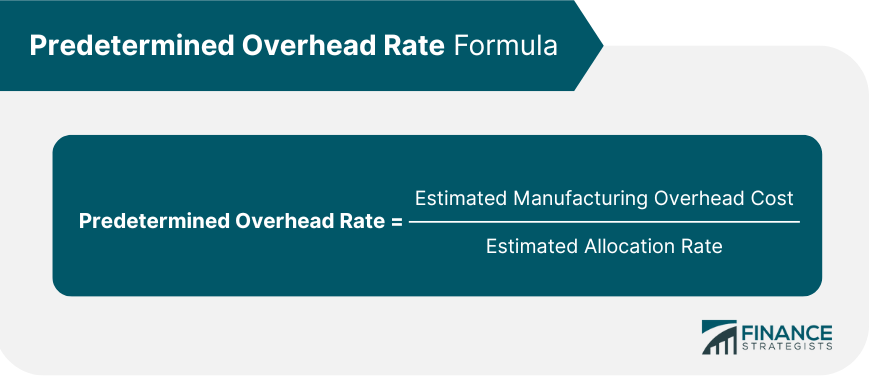A predetermined overhead rate is an allocation rate given for indirect manufacturing costs that are involved in the production of a product (or several products). It is used to estimate future manufacturing costs. The estimate is made at the beginning of an accounting period, before the commencement of any projects or specific jobs for which the rate is needed. The predetermined overhead rate is calculated using the following formula: The formula for the predetermined overhead rate is purely based on estimates. Hence, the overhead incurred in the actual production process will differ from this estimate. This difference is calculated at the end of the accounting period. It is known as either over-absorption or under-absorption of overheads. The allocation base (also known as the activity base or activity driver) can differ depending on the nature of the costs involved. The common allocation bases are direct labor hours, direct labor cost, machine hours, and direct materials. To further understand the formula, consider the following steps: Departmental overhead rates are needed because different processes are involved in production that take place in different departments. This example helps to illustrate the predetermined overhead rate calculation. Company B wants a predetermined rate for a new product that it will be launching soon. Its production department comes up with the details of how much the overheads will be and what other costs will be incurred. The pricing details are as follows: Since we need to calculate the predetermined rate, direct costs are ignored. The total manufacturing overhead cost will be the variable overhead plus fixed overhead. That is to say: 150,000+350,000=500,000. Total Manufacturing Overhead = 500,000 Labor hours amount to 2,000. Therefore, the predetermined rate is: Total manufacturing overhead/Direct labor hours = 500,000/2,000= 250 per direct labor hour Therefore, this rate of 250 is used in the pricing of the new product. If we change the allocation base to machine hours, the predetermined rate would be based on machine hours. For example: Manufacturing overhead/Direct machine hours = 500,000/4,500 = 111.11 per direct labor hour The predetermined overhead rate calculation shown in the example above is known as the single predetermined overhead rate or plant-wide overhead rate. Different businesses have different ways of costing; some use the single rate, others use multiple rates, and the rest use activity-based costing. Small companies tend to use activity-based costing, whereas in larger companies, each department in which different processes of production take place typically computes its own predetermined overhead rate. While it may become more complex to have different rates for each department, it is still considered more accurate and helpful because the level of efficiency and precision increases. There are still many points to consider before using a predetermined rate. The rates aren’t realistic because they are based on accounting estimates. The production hasn’t taken place and is completely based on forecasts or previous accounting records, and the actual overheads incurred could turn out to be way different than the estimate. Also, if the rates determined are nowhere close to being accurate, the decisions based on those rates will be inaccurate, too. This can result in abnormal losses as well and unexpected expenses being incurred. Unexpected expenses can be a result of a big difference between actual and estimated overheads. Profits will be affected and assets may need to be worked beyond their capacity too. Furthermore, historical data is not always the best for predicting, estimating, and forecasting. Prices increase all the time and industry trends and consumer expectations are constantly changing. To conclude, the predetermined rate is helpful for making decisions, but other factors should be taken into consideration, too.Predetermined Overhead Rate: Definition
Formula for Predetermined Overhead Rate

Predetermined Overhead Rate: Explanation
Example
Item
Base
Amount
Direct labor
Based on labor hours
200,000
Direct materials
Based on material units
250,000
Variable overhead
Based on labor hours
150,000
Fixed overhead
Based on labor hours
350,000
Direct labor hours
2000
Item
Base
Amount
Direct labor
Based on labor hours
200,000
Direct material
Based on material units
250,000
Variable overhead
Based on labor hours
150,000
Fixed overhead
Based on labor hours
350,000
Direct labor hours
1000
Direct machine hours
4500
Concerns Surrounding Predetermined Overhead Rates
Predetermined Overhead Rate FAQs
A predetermined overhead rate, also known as a plant-wide overhead rate, is a calculation used to determine how much of the total manufacturing overhead cost will be attributed to each unit of product manufactured. The rate is determined by dividing the fixed overhead cost by the estimated number of direct labor hours.
The predetermined overhead rate is used to price new products and to calculate variances in overhead costs. Variances can be calculated for actual versus budgeted or forecasted results.
There are concerns that the rate may not be accurate, as it is based on estimates rather than actual data. In addition, changes in prices and industry trends can make historical data an unreliable predictor of future overhead costs. Finally, using a predetermined overhead rate can result in inaccurate decision-making if the rate is significantly different from the actual overhead cost.
Small companies typically use activity-based costing, while large organizations will have departments that compute their own rates.
Direct labor standard rate, machine hours standard rate, and direct labor hours standard rate are some methods of factory overhead absorption.
True Tamplin is a published author, public speaker, CEO of UpDigital, and founder of Finance Strategists.
True is a Certified Educator in Personal Finance (CEPF®), author of The Handy Financial Ratios Guide, a member of the Society for Advancing Business Editing and Writing, contributes to his financial education site, Finance Strategists, and has spoken to various financial communities such as the CFA Institute, as well as university students like his Alma mater, Biola University, where he received a bachelor of science in business and data analytics.
To learn more about True, visit his personal website or view his author profiles on Amazon, Nasdaq and Forbes.











